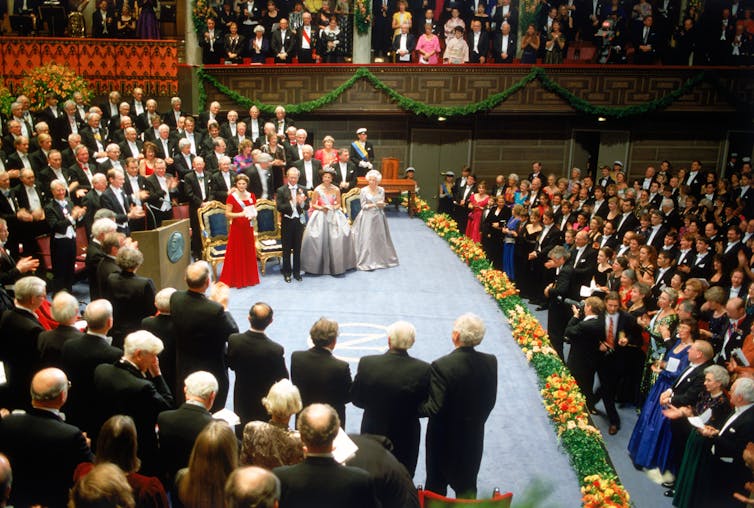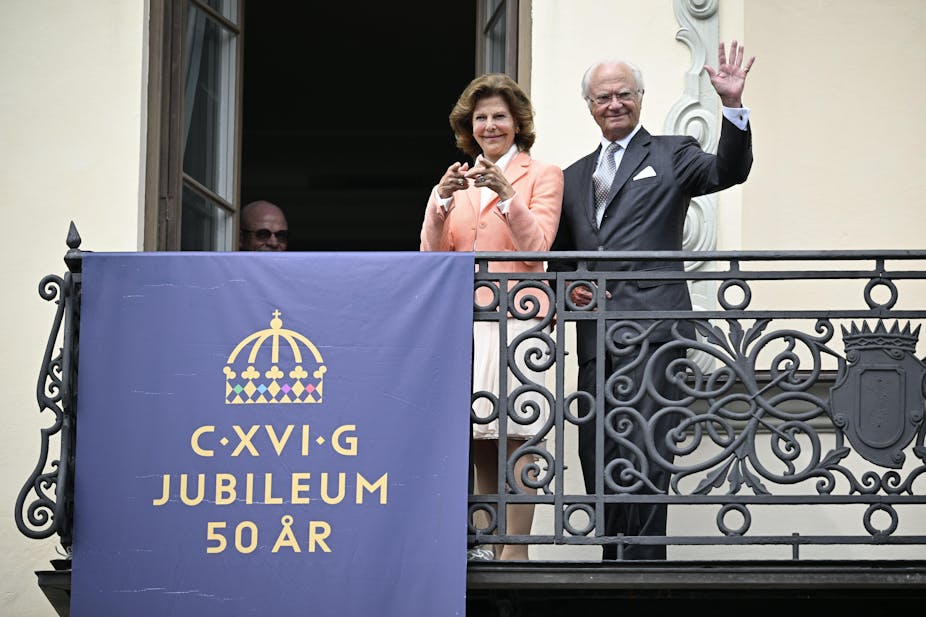The death of Queen Elizabeth II in September 2022 and the subsequent coronation of King Charles III eight months later, were international media events of historic proportions. People around the world observed, in close detail, how the UK’s royal institution consolidates its authority by using ritual to link to the past.
Over the weekend of September 15 and 16 2023, Sweden will celebrate its own royal occasion, the golden jubilee of King Carl XVI Gustaf. This represents a significant national moment. Several TV documentaries have been made. A plethora of books and magazines have been published. Podcasts have been recorded.
Since the 1970s, the Swedish crown has gained its legitimacy and popular support by being perceived as being above politics. This contemporary monarchy was the result of constitutional reforms implemented in the 1970s, which renounced extravagance and ritual.
The Swedish royal family garners notably less attention worldwide than the British monarchy. Where the British coronation ceremony, replete with ritual magic and religious symbolism, is notable for its extravagance, Sweden is characterised by a distinctive monarchical minimalism.

Our research shows that having little political power is precisely what gives the royal family continued cultural and political relevance in modern Sweden. This may be of interest to the British royal family if their popularity continues to decrease over time.
Towards a low-key monarchy
Of the nine remaining hereditary monarchies in Europe, the Swedish monarchy has the least power and resources. All European royal families are essentially politically powerless and play a minimal role in their governments’ affairs. However, quite how their constitutional role – and the societal and political meaning afforded them – is shaped, differs by country.
After Oscar II was crowned King in 1873, Sweden eschewed coronations in favour of a simpler – and crucially less expensive – inauguration. Royal regalia including the crown, sword and sceptre, were displayed, but not handed to the monarch.
From the 1950s, the political parties in Sweden agreed that constitutional reform was necessary. Reaching agreement on the fundamental principles, however, was a complicated, long-winded process. Many members of the Social Democratic party were pushing for the country to become a republic, while the more conservative voices sought to retain the monarchy.
In August 1971, a cross-party committee of inquiry convened in Torekov, a coastal town in southern Sweden, and agreed on what became known as the Torekov compromise.
This stipulated that the country would not become a republic with an elected president. Instead, it would remain a constitutional monarchy, with the Bernadotte dynasty holding the throne. The king, however, would be stripped of all constitutional powers – including the power to appoint the prime minister, sign government bills and preside over cabinet meetings.
The new constitution of 1974 drastically reduced the Swedish monarchy. As former prime minister Olof Palme put it: “There is only a plume left, a decoration.”
To Palme’s mind, very little now stood in the way of abolishing the monarchy entirely.
In 1979, the Swedish parliament voted to introduce gender-neutral succession. This placed the royal couple’s first-born child, a girl, ahead of her brother. By doing away with this antiquated tradition of male-preference primogeniture, the monarchy was aligned with modernity. This reflected the societal push for gender equality.
An ordinary (royal) family
After the 1974 constitutional shift, the media, too, emphasised the family’s ordinariness, their “just like us” quality.
Royal birthdays, marriages, deaths and births have, since the 1970s, been framed in emotional and intimate terms, as moments of national pleasure unrelated to politics and government.
The Year with the Royal Family has been part of Christmas scheduling on public service TV since 1977. This show introduces viewers to the royals’ everyday life and festive celebrations. A typical scene from 1985 features the family making sausages in the palace kitchen – the king in a red cardigan, the children in matching white aprons. Four decades on, it continues to be used in media coverage.
In 2010, the crown princess Victoria’s marriage to Daniel Westling drew thousands of people to Stockholm and was broadcast live to 3.2 million viewers. This emotional narrative centred on the couple being modern and gender-equal. Westling, a personal trainer, was often referred to as a “man of the people”.
These media portrayals have sought to underline quite how ordinary the royal family is and how the public might identify with them. Yet it is this very ordinariness that, paradoxically, confirms their special status. It is special that they are just like us, which of course confirms that they are not.

This specialness is clearly illustrated in the annual Nobel prize ceremony. The king hands out the medals on behalf of the Nobel committee. Pundits, meanwhile, focus on what the royal women are wearing. Media research has shown how the queen, in particular, becomes the focal point of the televised Nobel banquet – an aspirational symbol of traditional, ideal femininity and class.
In his 1995 book, Banal Nationalism, British social psychologist Michael Billig unpicks how nationalism is reproduced in everyday life via ordinary, unremarkable reminders.
Similarly, we might talk about “banal royalism” to describe how closely tied the Swedish royal institution is to the private lives of ordinary citizens – their superiority accentuated by their proximity to normal people.
It is precisely the monarch’s lack of political power and the royal family’s ordinariness that account for their strong position and the influence they continue to wield within Swedish society. If the Torekov compromise rendered Swedish royals powerless, it also gave the monarchy continued leverage.
The forthcoming golden jubilee, however, might just see this change. Members of the nationalist Sweden Democrats have argued for reintroducing previously discarded royal ceremonies and returning formal powers to the king.
These proposals may turn out to be a threat to the monarchy precisely because they politicise the institution. We insist that giving political power back to this enduring national symbol could well mark its demise.

